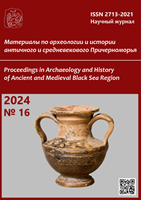Roman provincial coins found in the excavations of the Slope Bath of Parion (2008— 2018)
Roman provincial coins found in the excavations of the Slope Bath of Parion (2008— 2018)
Author(s): Vedat Keleş, Fatma Kızılyalçın OyarçinSubject(s): Archaeology, Economic history, Social history, Ancient World
Published by: Нижневартовский государственный университет
Keywords: Parion; slope bath; coin; province of Rome;
Summary/Abstract: This article focuses on the Roman provincial coins found during the excavations of the Parion Slope Bath between 2008 and 2018. A total of 58 coins were discovered, which belonged to Parion (41), Alexandria Troas (7), Coela (6), Lampsakos (2), Byzantion (1), and Ilion (1). The earliest of the coins dates to the reign of Julius Caesar (45 BCE), and the latest to the reign of Gallienus (253—268 CE). Seven of the coins are PseudoAutonomous. The coins found in the excavations of the Slope Bath represent three centuries, from the first Roman colonial coins minted by Parion during the reign of Julius Caesar to the end of the Gallienian period, when Parion minted its last colonial coins. The coins consist of examples of six different cities and 19 different emperors/empresses. Most of the coins are from Parion’s own mint, with 41 samples (71%). Furthermore, the coins recovered from the Slope Bath, which was built in the 1st century CE, underwent extensive renovation in the 4th century CE and is assumed to have fallen into disuse in the late 5th century CE, support the suggestions for the construction and early use phases of the bath. The coins in question also provide essential information about both the usage phases of the building and the circulation of Roman provincial coins in Parion, as well as the relations of Parion with the surrounding cities during the Roman Period.
Journal: Материалы по археологии и истории античного и средневекового Причерноморья
- Issue Year: 2024
- Issue No: 16
- Page Range: 697-724
- Page Count: 28
- Language: English

